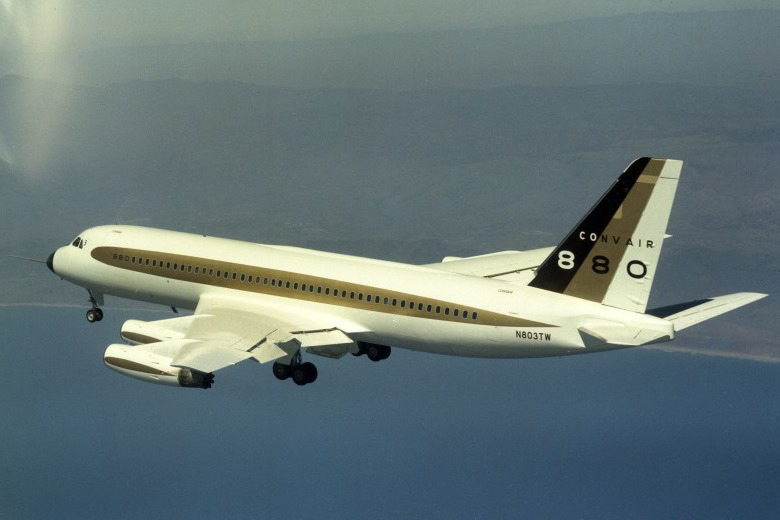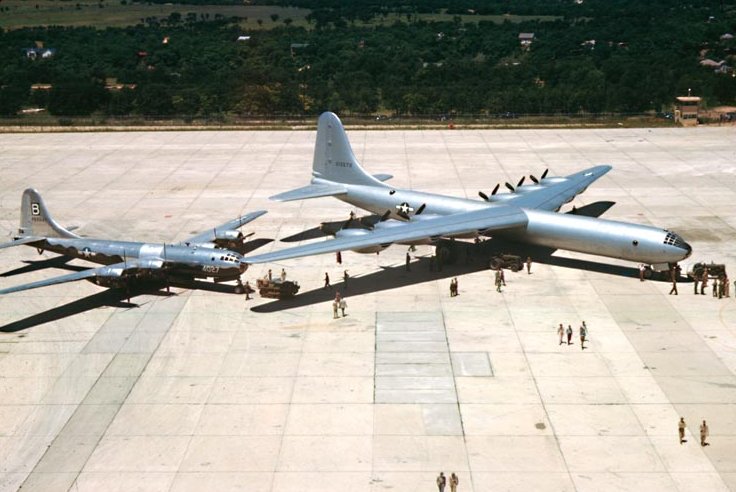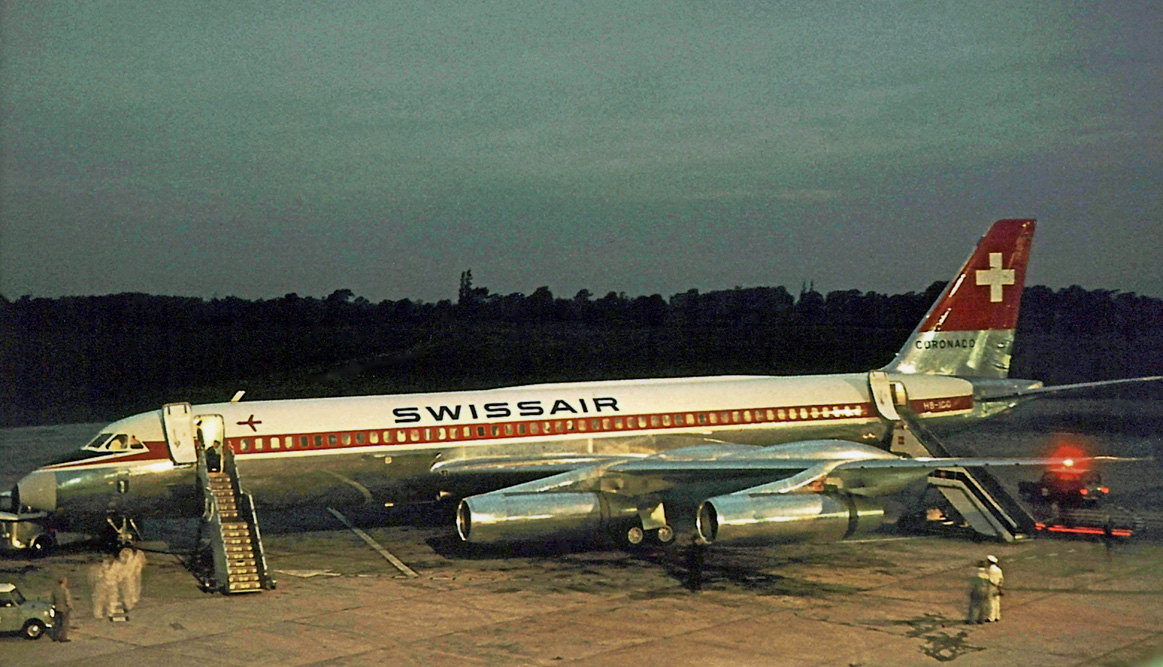|
Convair
Convair, previously Consolidated Vultee, was an American aircraft manufacturing company that later expanded into rockets and spacecraft. The company was formed in 1943 by the merger of Consolidated Aircraft and Vultee Aircraft. In 1953, it was purchased by General Dynamics, and operated as their Convair Division for most of its corporate history. Convair is best known for its military aircraft; it produced aircraft such as the Convair B-36 Peacemaker and Convair B-58 Hustler strategic bombers, and the Convair F-102 Delta Dagger and Convair F-106 Delta Dart interceptors. It also manufactured the first Atlas rockets, including the rockets that were used for the crewed orbital flights of Project Mercury. The company's subsequent Atlas-Centaur design continued this success and derivatives of the design remain in use as of 2020. The company also entered the jet airliner business with its Convair 880 and Convair 990 designs. These were smaller than contemporary aircraft li ... [...More Info...] [...Related Items...] OR: [Wikipedia] [Google] [Baidu] |
Convair 880
The Convair 880 is an American narrow-body jet airliner produced by the Convair division of General Dynamics. It was designed to compete with the Boeing 707 and Douglas DC-8 by being smaller but faster, a niche that failed to create demand. When it was first introduced, some in aviation circles claimed that at , it was the fastest jet transport in the world. Only 65 Convair 880s were produced over the lifetime of the production run from 1959 to 1962, and General Dynamics eventually withdrew from the airliner market after considering the 880 project a failure. The Convair 990 Coronado was a stretched and faster variant of the 880. Development Convair began development of a medium-range commercial jet in April 1956, to compete with announced products from Boeing and Douglas. Initially the design was called the Skylark, but the name was later changed to the Golden Arrow, then Convair 600 and then finally the 880, both numbers referring to its top speed of 600 mph (970 k ... [...More Info...] [...Related Items...] OR: [Wikipedia] [Google] [Baidu] |
Convair B-36 Peacemaker
The Convair B-36 "Peacemaker" is a strategic bomber that was built by Convair and operated by the United States Air Force (USAF) from 1949 to 1959. The B-36 is the largest mass-produced Reciprocating engine, piston-engined aircraft ever built. It had the longest wingspan of any combat aircraft ever built, at . The B-36 was the first bomber capable of delivering any of the nuclear weapons in the U.S. arsenal from inside its four bomb bays without aircraft modifications. With a range of and a maximum payload of , the B-36 was capable of intercontinental flight without refuelling. Entering service in 1948, the B-36 was the primary nuclear weapons delivery vehicle of Strategic Air Command (SAC) until it was replaced by the jet-powered Boeing B-52 Stratofortress beginning in 1955. All but four aircraft have been scrapped. Development The genesis of the B-36 can be traced to early 1941, prior to the entry of the United States into World War II. At the time, the threat existed that Bat ... [...More Info...] [...Related Items...] OR: [Wikipedia] [Google] [Baidu] |
Convair 990
The Convair 990 Coronado is an American narrow-body four-engined jet airliner produced between 1961 and 1963 by the Convair division of American company General Dynamics. It was a stretched version of its earlier Convair 880 produced in response to a request from American Airlines: the 990 was lengthened by , which increased the number of passengers from between 88 and 110 in the 880 to between 96 and 121. This was still fewer passengers than the contemporary Boeing 707 (110 to 189) or Douglas DC-8 (105 to 173), although the 990 was faster than either in cruise. Design and development American Airlines asked Convair to design an aircraft for coast-to-coast flights, able to fly nonstop from New York City to Los Angeles against the wind. They wanted a larger passenger capacity than the 880, which was the smallest of the first-generation U.S. jet airliners. It was known as the Convair 600 and was redesignated the Convair 990 in the month of its first flight. The 990 began flight t ... [...More Info...] [...Related Items...] OR: [Wikipedia] [Google] [Baidu] |
Convair B-58 Hustler
The Convair B-58 Hustler, designed and produced by American aircraft manufacturer Convair, was the first operational bomber capable of Mach 2 flight. The B-58 was developed during the 1950s for the United States Air Force (USAF) Strategic Air Command (SAC). To achieve the high speeds desired, Convair chose a delta wing design used by contemporary fighters such as the Convair F-102. The bomber was powered by four General Electric J79 engines in underwing pods. It had no bomb bay: it carried a single nuclear weapon plus fuel in a combination bomb/fuel pod underneath the fuselage. Later, four external hardpoints were added, enabling it to carry up to five weapons. The B-58 entered service in March 1960, and flew for a decade with two SAC bomb wings: the 43rd Bombardment Wing and the 305th Bombardment Wing. It was considered difficult to fly, imposing a high workload upon its three-man crews. Designed to replace the subsonic Boeing B-47 Stratojet strategic bomber, the B-58 bec ... [...More Info...] [...Related Items...] OR: [Wikipedia] [Google] [Baidu] |
Convair F-106 Delta Dart
The Convair F-106 Delta Dart was the primary all-weather interceptor aircraft of the United States Air Force from the 1960s through to the 1980s. Designed as the so-called "Ultimate Interceptor", it proved to be the last specialist interceptor in U.S. Air Force service to date. It was gradually retired during the 1980s, with the QF-106 drone conversions of the aircraft being used until 1998 under the ''Pacer Six'' program.Winchester 2006, p. 55. Development Antecedents The F-106 was the ultimate development of the USAF's 1954 interceptor program of the early 1950s. The initial winner of this competition had been the F-102 Delta Dagger, but early versions of this aircraft had demonstrated extremely poor performance, limited to subsonic speeds and relatively low altitudes. During the testing program the F-102 underwent numerous changes to improve its performance, notably the application of the area rule to the fuselage shaping and a change of engine, and the dropping of the advance ... [...More Info...] [...Related Items...] OR: [Wikipedia] [Google] [Baidu] |
Convair F-102 Delta Dagger
The Convair F-102 Delta Dagger was an American interceptor aircraft designed and manufactured by Convair. Built as part of the backbone of the United States Air Force's air defenses in the late 1950s, it entered service in 1956. Its main purpose was to intercept invading Soviet Union, Soviet strategic bomber fleets (primarily the Tupolev Tu-95) during the Cold War. A total of 1,000 F-102s were built. A member of the Century Series, the F-102 was the USAF's first operational supersonic interceptor and Delta wing, delta-wing fighter. It used an internal weapons bay to carry both guided missiles and rockets. As originally designed, it could not achieve Mach number, Mach 1 Supersonic speed#Supersonic flight, supersonic flight until redesigned with Area rule, area ruling. The F-102 replaced subsonic fighter types such as the Northrop F-89 Scorpion, and by the 1960s, it saw limited service in the Vietnam War in Escort fighter, bomber escort and Close air support, ground-attack r ... [...More Info...] [...Related Items...] OR: [Wikipedia] [Google] [Baidu] |
General Dynamics
General Dynamics Corporation (GD) is an American publicly traded, aerospace and defense corporation headquartered in Reston, Virginia. As of 2020, it was the fifth-largest defense contractor in the world by arms sales, and 5th largest in the United States by total sales. The company is a Fortune 100 company, and was ranked No. 94 in 2022. Formed in 1954 with the merger of submarine manufacturer Electric Boat and aircraft manufacturer Canadair, the corporation today consists of ten subsidiary companies with operations in 45 countries. The company's products include Gulfstream business jets, Virginia- and Columbia-class nuclear-powered submarines, Arleigh Burke-class guided-missile destroyers, M1 Abrams tanks and Stryker armored fighting vehicles. In 2021, General Dynamics had worldwide sales of $38.85 billion and a workforce of approximately 103,000 full-time employees. The current chairman and chief executive officer (CEO) is Phebe Novakovic. History Electric Boat ... [...More Info...] [...Related Items...] OR: [Wikipedia] [Google] [Baidu] |
Atlas-Centaur
The Atlas-Centaur was a United States expendable launch vehicle derived from the SM-65 Atlas D missile. Launches were conducted from Launch Complex 36 at the Cape Canaveral Air Force Station (CCAFS) in Florida. Early development Convair, the manufacturer of the Atlas, developed the Centaur upper stage specifically for that booster, sharing its pressure stabilized tank structure. Technical Centaur was the first rocket stage to utilize liquid hydrogen (LH2) and liquid oxygen (LOX) as propellants. Despite high performance, LH2 had to be chilled at extremely low temperatures (lower than LOX) and its low density meant that large fuel tanks were needed. The first attempt at using an LH2/LOX-fueled engine was the U.S. Air Force's top-secret Lockheed CL-400 Suntan reconnaissance aircraft program in the mid-1950s. The progress made during the aborted venture was picked up by Convair and others for rocket stage use. Originally, Centaur was conceived of as a purely experime ... [...More Info...] [...Related Items...] OR: [Wikipedia] [Google] [Baidu] |
Vultee Aircraft
The Vultee Aircraft Corporation became an independent company in 1939 in Los Angeles County, California. It had limited success before merging with the Consolidated Aircraft Corporation in 1943, to form the Consolidated Vultee Aircraft Corporation − or Convair. History Gerard "Jerry" Freebairn Vultee (1900–1938) and Vance Breese (1904–1973) started the Airplane Development Corporation in early 1932 after American Airlines showed great interest in their six-passenger V-1 design. Soon after, Errett Lobban (E.L.) Cord bought all 500 shares of stock in the company and the Airplane Development Corporation became a Cord subsidiary. AVCO subsidiary Due to the Air Mail Act of 1934, AVCO established the Aviation Manufacturing Corporation (AMC) on November 30, 1934 through the acquisition of Cord's holdings, including Vultee's Airplane Development Corporation. AMC was liquidated on January 1, 1936 and Vultee Aircraft Division was formed as an autonomous subsidiary of AVCO. ... [...More Info...] [...Related Items...] OR: [Wikipedia] [Google] [Baidu] |
Consolidated Aircraft
The Consolidated Aircraft Corporation was founded in 1923 by Reuben H. Fleet in Buffalo, New York, the result of the Gallaudet Aircraft Company's liquidation and Fleet's purchase of designs from the Dayton-Wright Company as the subsidiary was being closed by its parent corporation, General Motors.Yenne 2009, p. 15. Consolidated became famous, during the 1920s and 1930s, for its line of flying boats. The most successful of the Consolidated patrol boats was the PBY Catalina, which was produced throughout World War II and used extensively by the Allies. Equally famous was the B-24 Liberator, a heavy bomber which, like the Catalina, saw action in both the Pacific and European theaters. In 1943, Consolidated merged with Vultee Aircraft to form Consolidated-Vultee Aircraft, later known as Convair. History Consolidated Aircraft (and later Convair) had their headquarters in San Diego, California, on the border of Lindbergh Field (KSAN). Consolidated's first design was one of those purch ... [...More Info...] [...Related Items...] OR: [Wikipedia] [Google] [Baidu] |
Douglas DC-8
The Douglas DC-8 (sometimes McDonnell Douglas DC-8) is a long-range narrow-body airliner built by the American Douglas Aircraft Company. After losing the May 1954 US Air Force tanker competition to the Boeing KC-135, Douglas announced in July 1955 its derived jetliner project. In October 1955, Pan Am made the first order along with the competing Boeing 707, and many other airlines followed. The first DC-8 was rolled out in Long Beach Airport on April 9, 1958, and flew for the first time on May 30. FAA certification was achieved in August 1959 and the DC-8 entered service with Delta Air Lines on September 18. The six-abreast, low wing airliner was a four-engined jet aircraft with initial variants being long. The DC-8-10 was powered by Pratt & Whitney JT3C turbojets and had a MTOW, the DC-8-20 had more powerful JT4A turbojets for a MTOW. The intercontinental models had more fuel capacity and up to MTOW, powered by JT4As for the Series 30 and by Rolls-Royce Conway ... [...More Info...] [...Related Items...] OR: [Wikipedia] [Google] [Baidu] |
Jet Airliner
A jet airliner or jetliner is an airliner powered by jet engines (passenger jet aircraft). Airliners usually have two or four jet engines; three-engined designs were popular in the 1970s but are less common today. Airliners are commonly classified as either the large wide-body aircraft, medium narrow-body aircraft and smaller regional jet. Most airliners today are powered by jet engines, because they are capable of safely operating at high speeds and generate sufficient thrust to power large-capacity aircraft. The first jetliners, introduced in the 1950s, used the simpler turbojet engine; these were quickly supplanted by designs using turbofans, which are quieter and more fuel-efficient. History Early history The first airliners with turbojet propulsion were experimental conversions of the Avro Lancastrian piston-engined airliner, which were flown with several types of early jet engine, including the de Havilland Ghost and the Rolls-Royce Nene. They retained the two ... [...More Info...] [...Related Items...] OR: [Wikipedia] [Google] [Baidu] |








.jpg)

